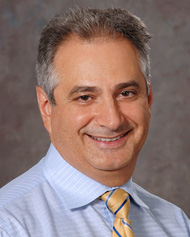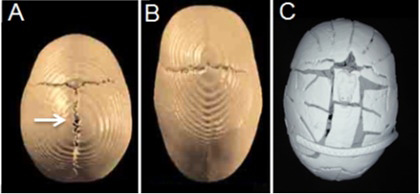International team of investigators discovers likely basis of birth defect causing premature skull closure in infants
Genetic differences identified in children with sagittal craniosynostosis
View this release en español or 中文 Chinese
An international team of geneticists, pediatricians, surgeons, and epidemiologists from 23 institutions across three continents have identified two areas of the human genome associated with the most common form of non-syndromic craniosynostosis ― premature closure of the bony plates of the skull.
"We have discovered two genetic factors that are strongly associated with the most common form of premature closure of the skull," said Simeon Boyadjiev, professor of pediatrics and genetics, principal investigator for the study, a researcher affiliated with the UC Davis MIND Institute, and leader of the International Craniosynostosis Consortium.

Simeon Boyadjiev
The study, "A genome-wide association study identifies susceptibility loci for non-syndromic sagittal craniosynostosis near BMP2 and within BBS9," is published online today in the journal, Nature Genetics.
During fetal and early child development, the skull is made of separate bony plates that allow for growth of the head. The borders between the plates do not normally fuse completely until a child is about 2 years old, leaving temporary "soft spots" at the intersection of the seams.
If the bones fuse too early ― the condition called craniosynostosis ― a child will develop an abnormally shaped head. Left untreated, the disorder causes complications due to brain compression, such as neurologic and visual problems and learning disabilities. Typically, craniosynostosis requires extensive neurosurgical correction.
About 20 percent of cases of craniosynostosis have previously been linked to a number of different genetic syndromes, but the vast majority of cases (not associated with a syndrome involving other birth defects) arise without any known family history or cause. The most common form of non-syndromic craniosynostosis ― affecting about 1 in 5,000 newborns ― involves the sagittal suture, the main seam that runs down the center of the top of the skull. These cases were the subject of the investigation.
Although the condition has long been thought to be partially determined by genes ― it is three times more common in boys than in girls, and identical twins are much more likely to both be affected than non-identical twins ― the exact basis was unclear.
To help determine the cause, the investigators conducted the first genome-wide association study for the disorder, which involves scanning the entire genome of a group of people with craniosynostosis and comparing it to a control group of people without the condition. The study searched for single nucleotide polymorphisms (abbreviated as SNPs and called "snips") that are associated with craniosynostosis. SNPs are DNA changes in which a single nucleotide differs from the usual one at that position. There are some three billion nucleotides, the basic building blocks of DNA, in the human genome.
The study first evaluated the DNA ― extracted from whole blood or oral samples ― of 214 children and both of their parents, who did not have the condition, and restricted their final analysis to a group of 130 non-Hispanic white child-parent trios. This approach reduces the genetic variability inherent to individuals from different ethnicities. Their results identified very strong associations to SNPs in two areas of the genome, coding for bone morphogenetic protein 2 (BMP2) and Bardet-Biedl syndrome 9 protein (BBS9). Both proteins are known to play a role in skeletal development.
The findings were replicated in another population of 172 cases of children with the condition and 548 unrelated controls. The extensive international collaboration came about because of the desire to include as many cases as possible worldwide to strengthen the findings.
"Our results provide strong evidence that non-syndromic sagittal craniosynostosis has a major genetic component and identifies where the problem is likely to originate. The genetic changes we discovered could provide important clues for explaining how craniosynostosis occurs. This will be a critical first step in determining how it might be prevented," Boyadjiev said.
Boyadjiev added that the genetic differences do not fully explain the development of the condition and that other genes and environmental factors are also likely important. He plans to extend the research to find the exact disease-causing genetic variants, to identify contributing environmental factors, and to study other types of craniosynostosis in various ethnic groups.

Three-dimensional computerized tomography images show normal skull with arrow pointing at the sagittal suture (A), narrow and elongated skull of a child with a closed sagittal suture (B), and a view of the skull after surgical correction of the sagittal craniosynostosis (C). Copyright UC Regents 2012
"The identification of two biologically plausible candidate genes affecting susceptibility to non-syndromic sagittal craniosynostosis provides promising leads in the search for understanding how these conditions develop," said Emily Harris, chief of the translational genomics research branch at the National Institutes of Health's Institute of Dental and Craniofacial Research.
Boyadjiev's coauthors on the study included: Cristina M. Justice, Yoonhee Kim and Alexander F. Wilson of the NIH's National Human Genome Research Institute; Garima Yagnik, Craig Senders, James Boggan, Marike Zwienenberg-Lee, and Jinoh Kim of UC Davis School of Medicine; Inga Peter, Ethylin Wang Jabs, Monica Erazo, Xiaoqian Ye, Edmond Ainehsazan, Lisong Shi and Peter J. Taub of Mount Sinai School of Medicine; Michael L. Cunningham of University of Washington and Seattle Children's Research Institute; Virginia Kimonis of UC Irvine School of Medicine; Tony Roscioli of University of New South Wales, Australia; Steven A. Wall and Andrew O.M. Wilkie, John Radcliffe Hospital, United Kingdom; Joan Stoler of Children's Hospital Boston; Joan T. Richtsmeier and Yann Heuzé of Pennsylvania State University; Pedro A. Sanchez-Lara of University of Southern California; Michael F. Buckley of SEALS, Australia; Charlotte M. Druschel, Michele Caggana and Denise M. Kay of of the Wadsworth Center, New York State Department of Health; James L. Mills of NIH's Eunice Kennedy Shriver National Institute of Child Health and Human Development; Paul A. Romitti of University of Iowa; Ophir D. Klein of UC San Francisco School of Medicine and Cyrill Naydenov of the Medical University, Sofia, Bulgaria.
The research was supported by grants from several components of the U.S. National Institutes of Health (NIH), including the National Institute of Dental and Craniofacial Research, the National Center for Research Resources, the Eunice Kennedy Shriver National Institute of Child Health and Human Development, the National Center for Advancing Translational Sciences, and the National Human Genome Research Institute. Some of the NIH funding was provided through the American Recovery and Reinvestment Act. The NIH also supported the study through its Intramural Research Program and through a contract to the Johns Hopkins University. Other support for the research was provided by the U.S. Centers for Disease Control and Prevention, the Robert Wood Johnson Foundation, the University of Southern California Child Health Research Career Development Program and the UCLA Child Health Research Career Development Program. Boyadjiev also is supported by the Children's Miracle Network endowed chair in pediatric genetics.




